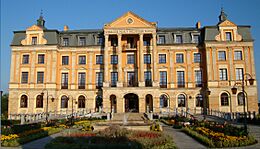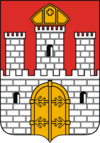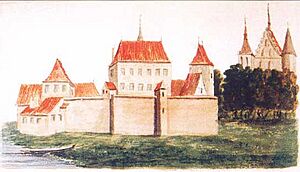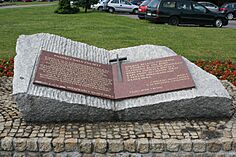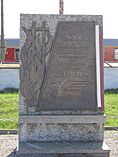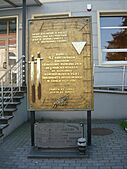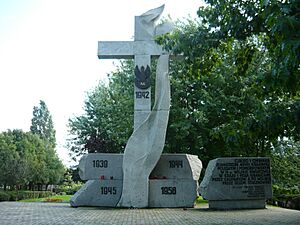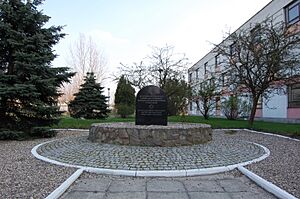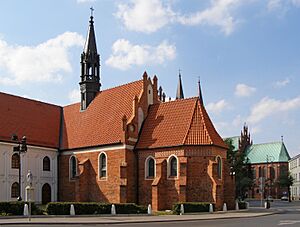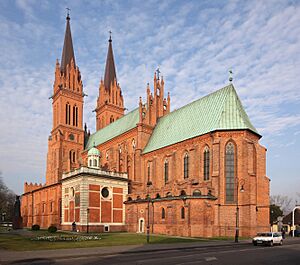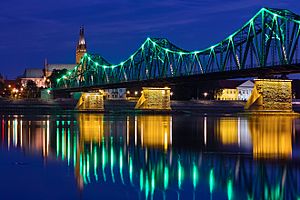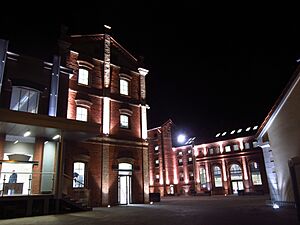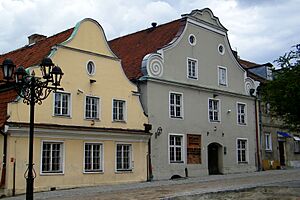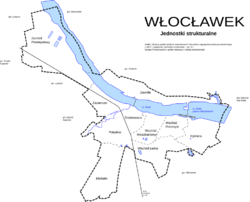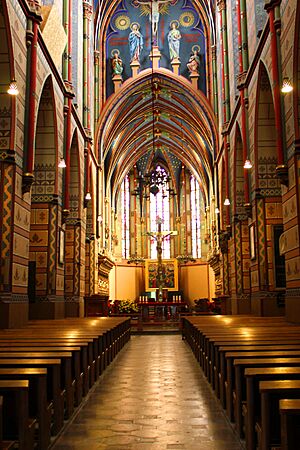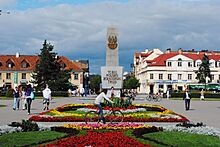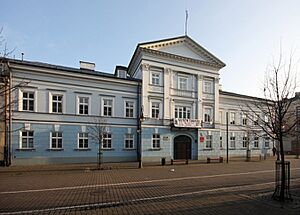Włocławek facts for kids
Quick facts for kids
Włocławek
|
|||
|---|---|---|---|
|
|||
|
|||
| Country | |||
| Voivodeship | |||
| Powiat | city county | ||
| Established | 9th century | ||
| First mentioned | 12th century | ||
| City rights | 1255 | ||
| Area | |||
| • City | 84.32 km2 (32.56 sq mi) | ||
| Population
(31 December 2021)
|
|||
| • City | 106,928 |
||
| • Metro | 210,516 (2005) | ||
| Time zone | UTC+01:00 (CET) | ||
| • Summer (DST) | UTC+02:00 (CEST) | ||
| Postal code |
87-800 to 87-810, 87-812, 87-814, 87-816 to 87-818, 87-822
|
||
| Area code(s) | +48 54 | ||
| Car plates | CW | ||
Włocławek (Polish: [vwɔˈt͡swavɛk]) is a city in central Poland. It is located in the Kuyavian–Pomeranian Voivodeship, right along the Vistula River. The city is also next to the Gostynin-Włocławek Landscape Park. As of December 2021, about 106,928 people live here.
Włocławek was founded in the 9th century. It is part of the historical region called Kuyavia. In the Middle Ages, it was the main city and administrative center of this region. Today, Włocławek is the third largest city in its voivodeship. It is an important cultural and economic hub for eastern Kuyavia. The city is home to the Roman Catholic Diocese of Włocławek, which is one of Poland's oldest dioceses, dating back to the 12th century. The famous Gothic Włocławek Cathedral is a Historic Monument of Poland. You can also find Poland's largest hydroelectric power plant here.
Contents
A Look at Włocławek's Past
Włocławek has a very long history. It goes all the way back to the late Bronze Age and early Iron Age (around 1300 BCE to 500 BCE). Digs in the city have found signs of old settlements. These include remains from the Lusatian culture and early Pomeranian culture. There are also traces of settlements from the Roman period and the early Middle Ages.
Włocławek in the Middle Ages
| Historical population | ||
|---|---|---|
| Year | Pop. | ±% |
| 1950 | 54,536 | — |
| 1960 | 66,820 | +22.5% |
| 1970 | 82,599 | +23.6% |
| 1980 | 106,771 | +29.3% |
| 1990 | 122,144 | +14.4% |
| 2000 | 121,833 | −0.3% |
| 2010 | 116,914 | −4.0% |
| 2020 | 108,561 | −7.1% |
The city started as a settlement in the 9th century. Its first people were farmers and craftspeople. In the 10th century, it became part of the new Polish state under the Piast dynasty. By the time of Bolesław I the Brave, Włocławek was already a key administrative center. The Gesta principum Polonorum chronicle from the 1110s mentions it. This is the oldest known mention of the city.
The name Włocławek comes from an Old Polish male name, Włodzisław. He might have been the city's founder. In the mid-10th century, under Casimir I the Restorer, Włocławek was an important administrative hub for Kuyavia.
One of the first mentions of the town was in 1123. An assistant to the Archbishop of Gniezno lived there. Later, in 1148, Pope Eugene III mentioned the Diocese of Włocławek in a special document. He named Warner as the first bishop.
In the 12th century, Włocławek had a mint for making coins. It also had a customs office. Here, tolls were collected from ships on the Vistula and Zgłowiączka rivers. A hospital was built around 1200. The local school was first mentioned in 1215.
Włocławek officially became a city in 1255. During the 14th and 15th centuries, the city was attacked and taken over many times by the Teutonic Knights. They even renamed it Leslau. The Treaty of Thorn in 1411 brought some peace. Włocławek also benefited from helping to ransom captured Teutonic Knights. The city was part of the Brześć Kujawski Voivodeship. It is thought that Nicolaus Copernicus, the famous astronomer, might have gone to the local cathedral school in the late 1400s.
Włocławek in Modern Times
The city grew rich from river trade. Grain from Kuyavia was shipped down the Vistula River. Tolls were collected on grain going to Gdańsk, Poland's main port. Timber from other rivers was also sent for export. The city was also known for its brewing. This is mentioned in a 1595 poem called Flis.
In 1569, Bishop Stanisław Karnkowski started a theology school in Włocławek. It is one of the oldest such schools in Poland. In 1625, the Reformed Franciscans came to Włocławek. Soon, their beautiful Baroque monastery was built.
The city suffered during wars. The Swedes attacked it in 1657. The Russians also caused damage in 1707. In 1790, Polish national hero Tadeusz Kościuszko visited Włocławek.
After Poland was divided in 1793, Włocławek became part of Prussia. It was a place of Polish resistance during the Kościuszko Uprising in 1794. Later, it became part of the Duchy of Warsaw in 1807. After the Congress of Vienna in 1815, it was part of Congress Poland under Russian rule. Polish freedom fighters were active here during the January Uprising of 1863–1864. They fought Russian troops in Włocławek in November 1863 and February 1864.
The oldest Polish religious journal, Ateneum Kapłańskie, has been published in Włocławek since 1909. The city was again damaged during battles in First World War.
When Poland became independent in 1918, local Poles disarmed the Germans. They freed the city. In 1920, Poles successfully defended Włocławek from Soviet invaders during the Polish–Soviet War.
Włocławek During World War II
During World War II, German troops occupied Włocławek. They entered the city on September 14, 1939. Under German rule, Włocławek was renamed Leslau. It became part of the German Reich.
In September 1939, Germans attacked a group of local Jewish people. They also burned synagogues. Many Polish people were arrested in October and November 1939. This was part of a plan to remove Polish leaders and thinkers. Many Catholic priests, teachers, and students from Włocławek were arrested. Some were sent to concentration camps, where many died.
Families of arrested Poles were forced to leave their homes. Their properties were given to German settlers. The Germans also took valuable historical items from the Diocese of Włocławek. They closed the cathedral. The city's main square, Plac Wolności ("Liberty Square"), was renamed Adolf-Hitler-Platz. By the end of the war, almost all of the more than 10,000 Jewish residents had been killed.
Włocławek was freed on January 20, 1945, by Soviet troops. One third of the city was destroyed. However, its factories and workshops were rebuilt by the Polish government in the years that followed.
The Jewish Community in Włocławek
The Jewish population in Włocławek grew over time. It went from 218 people in 1820 to 13,500 in 1939. Rabbi Leib Kowalski, a founder of the Mizracḥi movement, lived and worked here. Before World War II, the town had several Jewish schools and sports clubs.
When Germany occupied Poland, Włocławek was the first city where Jewish people had to wear special yellow badges. The Germans forced thousands of Włocławek's Jews into ghettos and labor camps. Many were later sent to extermination camps. Most of the Jewish community was lost during the war.
After the war, about 1000 Jewish people returned. They tried to rebuild their community. However, many left due to disagreements and not wanting to live under the new government. By the late 1960s, the Jewish community in Włocławek had mostly disappeared.
Today, there are very few signs of the once lively Jewish community. There is a memorial for victims of the Jewish ghetto in the Rakutówek neighborhood. There is also a Jewish Cemetery within the Municipal Cemetery.
Włocławek in Recent Years
Today, Włocławek's main industries are chemicals, furniture, and food processing. A dam was built in 1969. It controls the Vistula River's water level and created the Włocławek Reservoir. From 1975 to 1999, Włocławek was the capital of its own voivodeship.
Since 2012, the city has been part of a Special Economic Zone. This area offers tax benefits to companies that invest here.
Historical Places to See
- Copernicus Square (Polish: Plac Kopernika) is near the cathedral school. Nicolaus Copernicus might have studied here from 1488 to 1491. He and his teacher may have built a sundial for the Cathedral Basilica. In the square, you can see a monument to Copernicus. The main office of the Higher Seminary, founded in 1569, is also here.
- St. Witalis Church, built in 1330, is the oldest Gothic building in Włocławek. Inside, you can find Polish paintings from the 15th century. In front of the Cathedral Basilica, there is a monument to Stefan Wyszyński, an important Polish religious leader.
- Gothic Basilica Cathedral of St. Mary of the Assumption (Polish: Bazylika katedralna Wniebowzięcia Najświętszej Maryi Panny) was built between 1340 and 1411. It is one of Poland's oldest and tallest churches (86 meters). It is listed as a Historic Monument of Poland. Inside, you can find:
- A tombstone by Veit Stoss from 1493.
- A Renaissance chapel from 1604-1611.
- The oldest Gothic stained glass windows in Poland from 1360.
- A painting by Francisco de Zurbarán from the 17th century.
- The largest painting on a single board in Poland from 1470.
- Stained glass windows by Józef Mehoffer.
- A sculpture of The Last Supper from 1505.
- A very grand silver Eucharistic Throne from 1744.
- The Henryk Sienkiewicz Municipal Park is one of Poland's oldest parks. It has a statue of Henryk Sienkiewicz, a famous writer who won the Nobel Prize for Quo Vadis.
- Bishop's Palace (Polish: Pałac Biskupi) is on Gdanska street by the river. It was a bishop's home from 1858 to 1861 and has a garden.
- Marshall Józef Piłsudski Boulevards (Polish: Bulwary im. Marszałka Józefa Piłsudskiego): Here you can see historic houses, the Church of St. John the Baptist, and the Edward Rydz-Smigły Bridge. There are also art and ethnographic museums.
- Brewery B Culture Center. This used to be a brewery built in 1832. Now it's a modern culture center with a concert hall, a small cinema, and a museum.
- Black Granary (Polish: Czarny Spichrz) was built between the 18th and 19th centuries. It's a unique building that still stands in Poland.
- Church of St. John the Baptist (Polish: Kościół pw. Św. Jana Chrzciciela) has Gothic and Baroque styles. It was built in 1538. The inside is Baroque, with a Guardian Angel painting from 1635.
- All Saints Church and Franciscan-Reformers Cloister (Polish: Parafia i Klasztor Ojców Franciszkanów) was built in 1639–1644. It has Baroque style with some Gothic parts.
- Evangelical church was built 1877–79. A wooden church was here in the 17th century.
- Liberty (Freedom) Square (Polish: Plac Wolności) is the city's central square. It has a monument to Polish soldiers of World War II. You can also find a historic hotel, restaurants, banks, and shops here.
- The Włocławek Dam (Polish: Zapora Wodna na Wiśle, Tama we Włocławku) was built in 1970. It is the largest water reservoir in Poland.
- Wzorcownia is a shopping and entertainment center. It used to be a factory built in 1873.
- Green Market (Polish: Zielony Rynek) is a historical trading place. It has old houses from the 19th and 20th centuries.
- Municipal/Communal Cemetery (Polish: Cmentarz Komunalny we Włocławku) is the main cemetery. It has sections for Polish, Jewish, German, and Russian people. There are also graves for victims of World War I and World War II.
- Many World War II memorials are found throughout the city.
Museums to Explore

- Diocesan Museum
This museum is next to the Basilica Cathedral. It has paintings by Guercino and prints by Albrecht Dürer. The Seminary Library has old manuscripts from the 1500s.
- Museum of the Kujawy and Dobrzyn Land
- Main Building
This building has two main displays. One is about "Włocławek`s Faience" (a type of pottery). The other is "The Gallery of Polish Portraits." It shows works by famous Polish painters like Józef Simmler and Leon Wyczółkowski. You can also see art by Anthony van Dyck.
- The Ethnography Museum
This museum is in an old granary. It shows important parts of local folk culture. You can see old farming tools, fishing gear, pottery, and musical instruments.
- The Museum of the History of Włocławek
This museum is in two historic Baroque houses. They show items from Włocławek's history, from ancient times to 1945. You can see old coins, armor, and items from the city's economic life. There are also photos and items from national uprisings and wars.
- The Art Collection
A large art collection is in a granary built in 1839. It has two main displays. One is religious art, including sculptures by Stanisław Zagajewski. The other shows works by Wacław Bębnowski, including ceramic sculptures. You can also see Italian, German, and Dutch art from the 17th and 18th centuries. This includes paintings by Carlo Cignani and prints by Rembrandt van Rijn.
Włocławek's Neighborhoods
- Michelin
- Południe (South)
- Rybnica
- Śródmieście (City center)
- Wschód Leśny (East forest area)
- Wschód Mieszkaniowy (East residential area), also known as Dzielnica Wschód (East District)
- Wschód Przemysłowy (East industrial area), also known as Dzielnica Wschód (East District)
- Zachód Przemysłowy (West industrial area)
- Zawiśle
- Zazamcze
Culture and Fun Activities
- Culture center Browar B
- OSIR - A sports center with a new football stadium, swimming pool, aqua park, and tennis courts.
- Yacht areas: Przystań nad Wisłą OSIR we Włocławku, Przystań OSIR nad Zalewem Włocławskim, and Marina Yacht Club Anwil in Zarzeczewo.
- Wakepark Włocławek
- Theaters: Teatr Impresaryjny im. W. Gniazdowskiego, Teatr "Nasz", Teatr Skene.
- Art Galleries: Gallery of Modern Art, Galeria at Kuyavia-Dobrzyń Culture Society, Galeria SK, Galeria Migawka, Galeria Antresola.
- Music clubs and Discos, including Million Club and Lucky Star Bowling Wzorcownia.
- Gostynin-Włocławek Landscape Park with over 40 lakes.
- Rope parks: Park Linowy Włocławek Jezioro Czarne and Park Linowy Włocławek Aleja Kazimierza Wielkiego.
- Airport Kruszyn and Aeroklub Włocławek for aviation fans.
- Shopping and entertainment centers: Wzorcownia Włocławek and Focus Park Włocławek.
- Horse clubs: Arabians Falborek, Pensjonat Michelin, Klub Jeździecki Bogucin.
- Golfclub Kujawy
- Diving center Mr Jacques
- Quad-Park in Włocławek
- Fitness and Gymnastic clubs: Klub Forma, Pure Fitness, or Herkules.
- Judo and Karate Center IKT
- Games centers: Lucky Star Bowling Wzorcownia (bowling, snooker, darts) or Sport Bowling Włocławek.
- Paintball clubs
- A great network of bike lanes.
Sports Teams
- Anwil Włocławek – A men's basketball team. They play in Poland's top league and have won the Polish Championship three times (2003, 2018, 2019).
- Włocłavia Włocławek – A men's football (soccer) team. They play in lower leagues but were once in the Polish second tier.
- Włocławek Rowing Society (Włocławskie Towarzystwo Wioslarskie) – A rowing team. They have been Polish and world champions. This club was started in 1886.
Business and Economy
Włocławek is home to many important companies. Some of the major ones include:
- Anwil SA - Part of the Orlen Group, Poland.
- Brügmann sp. z o.o. - Part of the Salamander Industrie Produkte Group, Germany.
- Guala Closures DGS Poland SA - Italy.
- Indorama Ventures - Poland, India/Thailand.
- PSH Lewiatan - Poland.
- Wika Polska - Germany.
Many other international companies also have branches here. These include Delecta (Norway), Top2000 (France), and Solvay (Belgium). Many transport and logistics companies also have offices in or near the city.
Since 2012, Włocławek has been part of the Pomeranian Special Economic Zone. This area, called the Włocławek Economic Development Area, offers tax-free zones and benefits for investors. The city is well-connected by major highways (A1 and A2), national roads, and a riverway to Gdańsk. It also has a fast rail line. Włocławek has its own power plants.
Another investment area is Teren Inwestycyjny Papieżka. It has full services and a railway connection. There are also large investment zones near Włocławek, such as in Brześć Kujawski. This area is right by the A1 motorway and a railway line. It has lots of open land for different businesses.
Education Opportunities
Włocławek has several universities and colleges:
- Państwowa Szkoła Wyższa PSWW Włocławek (Higher State School in Włocławek)
- Wyższa Szkoła Humanistyczno-Ekonomiczna WSHE Włocławek (College of Humanistics and Economics in Włocławek)
- Wyższa Szkoła Techniczna Włocławek (Higher Technical School in Włocławek)
- Wyższa Szkoła Informatyki i Umiejętności Łódź, a branch in Włocławek (Higher School of IT and Skills)
- Uniwersytet Mikołaja Kopernika w Toruniu Wydział Teologiczny we Włocławku (Nicolaus Copernicus University in Toruń, Faculty of Theology in Włocławek)
High Schools
- I LO im. Ziemi Kujawskiej, ul. Mickiewicza 6. This is one of the best high schools in the city.
- The school started in the early 1900s as the Włocławskie Siedmioklasowej School of Economics.
- Publiczne Liceum im. Jana Długosza we Włocławku
- II LO im. Mikołaja Kopernika, ul. Urocza 3
- III LO im. Marii Konopnickiej, ul. Bechiego 1
- IV LO im. Kamila Krzysztofa Baczyńskiego, ul. Kaliska 108
- V LO im. Unii Europejskiej, ul. Toruńska 77/83
Twin Cities
Włocławek has friendly connections with these cities:
Famous People from Włocławek
- Sholem Asch (1880 –1957), a Polish-Jewish writer.
- Katy Carr (born 1980), a British singer who spent her childhood here.
- Nicolaus Copernicus (1473–1543), the famous astronomer, may have studied here.
- Anton Denikin (1872–1947), a Russian Lieutenant General.
- Jerzy Engel (born 1952), a former coach of the Poland national football team.
- Roman Kozłowski (1889–1977), a Polish paleontologist.
- Julian Marchlewski (1866–1925), a Polish and German political figure, born in Włocławek.
- Leon Marchlewski (1869–1946), a Polish chemist.
- Aharon Megged (1920–2016), an Israeli author.
- Henryk Muszyński (born 1933), a Polish bishop.
- Jan Nagórski (1888–1976), a Polish engineer and aviation pioneer. He was the first person to fly over the North Pole.
- Pawel Pogorzelski (born 1979), a Polish-born Canadian cinematographer.
- Jerzy Popiełuszko (1947–1984), a Polish Catholic priest connected with the Solidarity trade union.
- Bernard Pullman (1919–1996), a French theoretical quantum chemist.
- Marcel Reich-Ranicki (1920–2013), a German literary critic.
- Tadeusz Reichstein (1897–1996), a Polish-Swiss Nobel Prize winner in chemistry.
- Maryla Rodowicz (born 1945), a popular Polish singer.
- Chaim F. Shatan (1924–2001), a Canadian physician and psychiatrist.
- Marie Steiner-von Sivers (1867–1948), a German-Russian co-founder of Anthroposophy.
- Jakub Świnka (?–1314), a Polish bishop.
- Henri Tajfel (1919–1982), a Polish social psychologist.
- Joseph Tykociński-Tykociner (1877–1969), a Polish engineer and pioneer of sound-on-film technology.
- Stefan Wyszyński (1901–1981), an important Polish bishop and cardinal.
- Stanisław Zagajewski (c. 1927–2007), a self-taught sculptor.
Images for kids
See also
 In Spanish: Włocławek para niños
In Spanish: Włocławek para niños






